13.5: The Desert Biome
- Page ID
- 16155
\( \newcommand{\vecs}[1]{\overset { \scriptstyle \rightharpoonup} {\mathbf{#1}} } \)
\( \newcommand{\vecd}[1]{\overset{-\!-\!\rightharpoonup}{\vphantom{a}\smash {#1}}} \)
\( \newcommand{\dsum}{\displaystyle\sum\limits} \)
\( \newcommand{\dint}{\displaystyle\int\limits} \)
\( \newcommand{\dlim}{\displaystyle\lim\limits} \)
\( \newcommand{\id}{\mathrm{id}}\) \( \newcommand{\Span}{\mathrm{span}}\)
( \newcommand{\kernel}{\mathrm{null}\,}\) \( \newcommand{\range}{\mathrm{range}\,}\)
\( \newcommand{\RealPart}{\mathrm{Re}}\) \( \newcommand{\ImaginaryPart}{\mathrm{Im}}\)
\( \newcommand{\Argument}{\mathrm{Arg}}\) \( \newcommand{\norm}[1]{\| #1 \|}\)
\( \newcommand{\inner}[2]{\langle #1, #2 \rangle}\)
\( \newcommand{\Span}{\mathrm{span}}\)
\( \newcommand{\id}{\mathrm{id}}\)
\( \newcommand{\Span}{\mathrm{span}}\)
\( \newcommand{\kernel}{\mathrm{null}\,}\)
\( \newcommand{\range}{\mathrm{range}\,}\)
\( \newcommand{\RealPart}{\mathrm{Re}}\)
\( \newcommand{\ImaginaryPart}{\mathrm{Im}}\)
\( \newcommand{\Argument}{\mathrm{Arg}}\)
\( \newcommand{\norm}[1]{\| #1 \|}\)
\( \newcommand{\inner}[2]{\langle #1, #2 \rangle}\)
\( \newcommand{\Span}{\mathrm{span}}\) \( \newcommand{\AA}{\unicode[.8,0]{x212B}}\)
\( \newcommand{\vectorA}[1]{\vec{#1}} % arrow\)
\( \newcommand{\vectorAt}[1]{\vec{\text{#1}}} % arrow\)
\( \newcommand{\vectorB}[1]{\overset { \scriptstyle \rightharpoonup} {\mathbf{#1}} } \)
\( \newcommand{\vectorC}[1]{\textbf{#1}} \)
\( \newcommand{\vectorD}[1]{\overrightarrow{#1}} \)
\( \newcommand{\vectorDt}[1]{\overrightarrow{\text{#1}}} \)
\( \newcommand{\vectE}[1]{\overset{-\!-\!\rightharpoonup}{\vphantom{a}\smash{\mathbf {#1}}}} \)
\( \newcommand{\vecs}[1]{\overset { \scriptstyle \rightharpoonup} {\mathbf{#1}} } \)
\(\newcommand{\longvect}{\overrightarrow}\)
\( \newcommand{\vecd}[1]{\overset{-\!-\!\rightharpoonup}{\vphantom{a}\smash {#1}}} \)
\(\newcommand{\avec}{\mathbf a}\) \(\newcommand{\bvec}{\mathbf b}\) \(\newcommand{\cvec}{\mathbf c}\) \(\newcommand{\dvec}{\mathbf d}\) \(\newcommand{\dtil}{\widetilde{\mathbf d}}\) \(\newcommand{\evec}{\mathbf e}\) \(\newcommand{\fvec}{\mathbf f}\) \(\newcommand{\nvec}{\mathbf n}\) \(\newcommand{\pvec}{\mathbf p}\) \(\newcommand{\qvec}{\mathbf q}\) \(\newcommand{\svec}{\mathbf s}\) \(\newcommand{\tvec}{\mathbf t}\) \(\newcommand{\uvec}{\mathbf u}\) \(\newcommand{\vvec}{\mathbf v}\) \(\newcommand{\wvec}{\mathbf w}\) \(\newcommand{\xvec}{\mathbf x}\) \(\newcommand{\yvec}{\mathbf y}\) \(\newcommand{\zvec}{\mathbf z}\) \(\newcommand{\rvec}{\mathbf r}\) \(\newcommand{\mvec}{\mathbf m}\) \(\newcommand{\zerovec}{\mathbf 0}\) \(\newcommand{\onevec}{\mathbf 1}\) \(\newcommand{\real}{\mathbb R}\) \(\newcommand{\twovec}[2]{\left[\begin{array}{r}#1 \\ #2 \end{array}\right]}\) \(\newcommand{\ctwovec}[2]{\left[\begin{array}{c}#1 \\ #2 \end{array}\right]}\) \(\newcommand{\threevec}[3]{\left[\begin{array}{r}#1 \\ #2 \\ #3 \end{array}\right]}\) \(\newcommand{\cthreevec}[3]{\left[\begin{array}{c}#1 \\ #2 \\ #3 \end{array}\right]}\) \(\newcommand{\fourvec}[4]{\left[\begin{array}{r}#1 \\ #2 \\ #3 \\ #4 \end{array}\right]}\) \(\newcommand{\cfourvec}[4]{\left[\begin{array}{c}#1 \\ #2 \\ #3 \\ #4 \end{array}\right]}\) \(\newcommand{\fivevec}[5]{\left[\begin{array}{r}#1 \\ #2 \\ #3 \\ #4 \\ #5 \\ \end{array}\right]}\) \(\newcommand{\cfivevec}[5]{\left[\begin{array}{c}#1 \\ #2 \\ #3 \\ #4 \\ #5 \\ \end{array}\right]}\) \(\newcommand{\mattwo}[4]{\left[\begin{array}{rr}#1 \amp #2 \\ #3 \amp #4 \\ \end{array}\right]}\) \(\newcommand{\laspan}[1]{\text{Span}\{#1\}}\) \(\newcommand{\bcal}{\cal B}\) \(\newcommand{\ccal}{\cal C}\) \(\newcommand{\scal}{\cal S}\) \(\newcommand{\wcal}{\cal W}\) \(\newcommand{\ecal}{\cal E}\) \(\newcommand{\coords}[2]{\left\{#1\right\}_{#2}}\) \(\newcommand{\gray}[1]{\color{gray}{#1}}\) \(\newcommand{\lgray}[1]{\color{lightgray}{#1}}\) \(\newcommand{\rank}{\operatorname{rank}}\) \(\newcommand{\row}{\text{Row}}\) \(\newcommand{\col}{\text{Col}}\) \(\renewcommand{\row}{\text{Row}}\) \(\newcommand{\nul}{\text{Nul}}\) \(\newcommand{\var}{\text{Var}}\) \(\newcommand{\corr}{\text{corr}}\) \(\newcommand{\len}[1]{\left|#1\right|}\) \(\newcommand{\bbar}{\overline{\bvec}}\) \(\newcommand{\bhat}{\widehat{\bvec}}\) \(\newcommand{\bperp}{\bvec^\perp}\) \(\newcommand{\xhat}{\widehat{\xvec}}\) \(\newcommand{\vhat}{\widehat{\vvec}}\) \(\newcommand{\uhat}{\widehat{\uvec}}\) \(\newcommand{\what}{\widehat{\wvec}}\) \(\newcommand{\Sighat}{\widehat{\Sigma}}\) \(\newcommand{\lt}{<}\) \(\newcommand{\gt}{>}\) \(\newcommand{\amp}{&}\) \(\definecolor{fillinmathshade}{gray}{0.9}\)The desert biome has the lightest cover of plants of any biome. Lack of moisture prevents plants from establishing themselves in this harsh climate. Many unique adaptations to the extreme heat and lack of moisture enable some plants to survive. Plants adapted to drought are called xerophytes. Aridisol soils, common to deserts, are typically coarse, lack much organic material, and are often weakly developed.
Dry Desert
The dry deserts are typically found in subtropical latitudes and are produced by subsidence associated with the eastern sides of the subtropical high. These are extremely dry regions, some places hardly receiving any measurable precipitation during the year. Plant cover is non-existent over much of the dry desert.
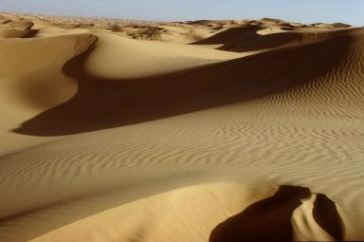
Like many dry deserts, a layer of coarse material blankets the surface. This "desert pavement" protects the underlying surface from erosion. When disturbed, wind easily dislodges particles and transports them away in a process called deflation. This makes the establishment of plants very difficult.
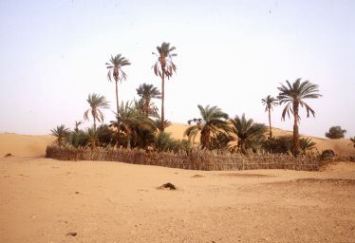
Plants occur only under the most favorable microclimatic settings like those surrounding an oasis. Oases are created where the water table is near the surface. Groundwater can be easily extracted to support vegetation and wildlife.
Plant growth and reproduction are quite slow under desert conditions. Surface erosion by wind or water restricts the establishment of plants. Infrequent storms causes water to sweep across the barren surface carrying away massive amounts of material along with plants. The rapid movement of sand dunes covers and prevents the establishment of a plant cover too.
Shrub Desert
The Shrub desert of the midlatitudes supports a more diverse community of plants and animals. Associated with the midlatitude desert climate, more precipitation and cooler temperatures help support a more complete ground cover. This is especially true along dry stream beds where moisture is often more plentiful. Large cacti like the Saguaro cactus, and xerophytic shrubs are found in the Shrub desert of North America.
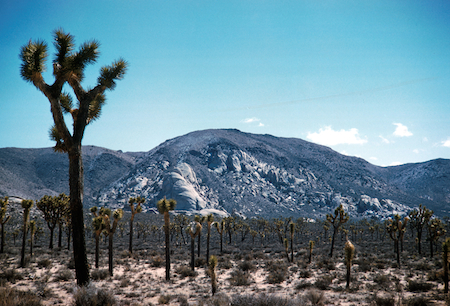
Some xerophytic vegetation are widely spaced, and have extensive root systems to capture moisture in the soil. Others have waxy leaves or fleshy tissues to store moisture. Enlarged green stems like those found on cacti take over the function of leaves in photosynthesis. Some desert vegetation may shed parts of branches during extreme drought.
Deserts have been expanding worldwide in response to several natural and human-induced reasons. Learn more by "Digging Deeper into Desertification" or skip and continue reading.
Desertification is the expansion of dry lands due to poor agricultural practices (e.g. overgrazing, degradation of soil fertility and structure), improper soil moisture management, salinization and erosion, forest removal, and climate change.
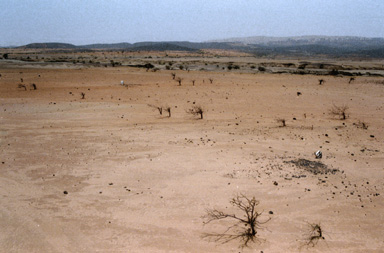
Two common misconceptions prevail about desertification, that it spreads from a desert core and drought is responsible. Desertification spreads outward from any where excessive abuse of the land occurs and far from any climatic desert. Droughts do increase the possibility of desertification if the carrying capacity of non-irrigated land is exceeded. Well-managed land can recover from the effects of drought. Combining drought with land abuse sets the stage for desertification.
Cause of Desertification
Desertification comes about by a complex interaction between the natural environment and human activities. The cause may vary from region to region on account of economic conditions, population pressure, agricultural practices, and politics. Human activities that destroys surface vegetation, degrades soil structure and fertility, impedes water infiltration, and causes soil drying promotes desertification. This is especially true for the fragile transition zone between arid and semiarid land where human activity has stretched the ecosystem to its limit causing expansion of deserts.
Population growth and its demand on agricultural resources has promoted the desertification process. Over cultivation, for example, causes declining soil fertility leading to falling crop yields. Over use leads to crusting of exposed topsoil by rain and sun that increases runoff, water erosion and gullying. Soil drying promotes wind erosion and encroachment of sand dunes on arable land.
Overgrazing has several effects. It:
- Causes a decline in pasture vegetation and palatable grass species.
- Replaces perennials with short-lived annual species that do not hold soil against erosion.
- Compacts soil under trampling hoofs.
- Destabilizes dunes when crest vegetation is eaten.
Forest cutting for fuel wood has deforested large tracks of land in Africa and Asia encouraging desertification.
Desertification around the world
The United Nations Conference on Desertification ranks desertification hazard on the basis of a drop in agricultural productivity:
None - less than 10%
Moderate - 10% to 25 %
High - 25% to 50%
Very high - more than 50%
Desertification is a global problem occurring in many places but is prevalent along the margins of semiarid and arid lands in Asia, central Australia, portions of North and South America, and Africa. A world map prepared by the United States NRCS shows just how widespread the problem is.
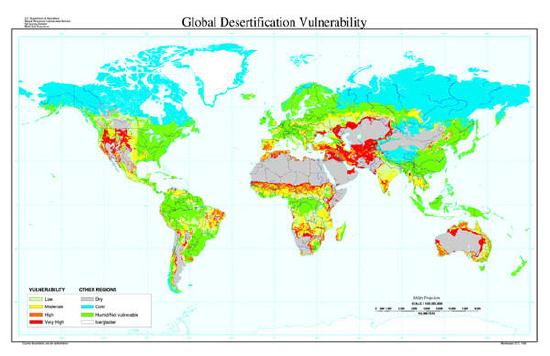
Africa has been significantly impacted by desertification. Almost three quarters of Africa's agricultural drylands are already degraded to some degree. The impact on desertification on the greatest number of people occurs in Asia. Degraded regions include the sand dunes of Syria, the eroded mountain slopes of Nepal, and the deforested and overgrazed highlands of Laos. The Northern Mediterranean region is the cradle of civilization and has borne the effects of poor agricultural practices. Salinized, infertile soils are the result of natural hazards e.g. droughts, floods and forest fire, as well as overtilling and overgrazing. Soil degradation is high through much of Central and Eastern Europe, and very high in some areas, for example along the coast of the Adriatic Sea. Poor irrigation practices and the unsustainable exploitation of water resources are contributing to chemical pollution, soil salinization and aquifer depletion. Nearly a quarter of the inhabitants of Latin America and the Caribbean live below the poverty line fueling practices that lead to land degradation. Erosion and water shortages are intensifying in many East Caribbean islands.


